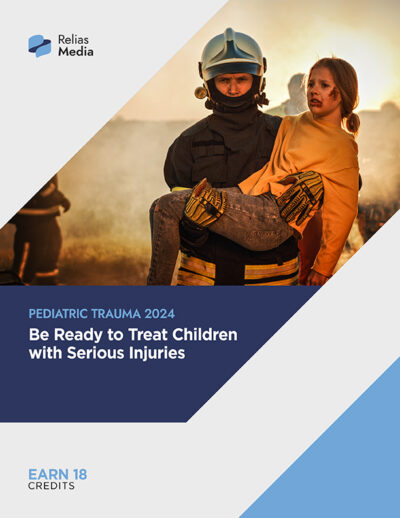
Pediatric Trauma 2024: Be Ready to Treat Children with Serious Injuries
Price: $159.00
Product Details
The latest installment in an award-winning series, Pediatric Trauma 2024: Be Ready to Treat Children with Serious Injuries facilitates excellence by covering the latest scientific information on caring for children who present with traumatic injuries. Perfect for pediatric trauma programs, this book provides 18 hours of pediatric trauma-specific CME/CE credits, meeting the yearly requirements for trauma-certified professionals.
Pediatric Trauma 2024 topics include:
- Identifying Pediatric Cervical Spine Injuries: Review how to identify and manage cervical spine injuries.
- Diagnosing and Managing Pediatric Foreign Body Ingestions: Part I: Review how to diagnose various kinds of common foreign bodies in pediatric patients.
- Diagnosing and Managing Pediatric Foreign Body Ingestions: Part II: Review management best practices for foreign bodies in pediatric patients, including some rarer cases.
- Identifying and Treating Pediatric Ocular Trauma: Review ocular anatomy and the injuries that may result from trauma to the eyes as well as a timely critical approach to treatment.
- Computed Tomography Scans in Pediatric Trauma: Review both the benefits and the risks of pediatric CT scans to help make more informed imaging decisions.
- Pediatric Chest Trauma: Review the essential steps for diagnosis and management of pediatric thoracic injuries.
Features:
- Provides latest evidence on how to best treat children who have experienced a traumatic event
- Includes valuable tables, figures, charts, photographs, and images to support the information
- Easy format for physicians and nurses to earn pediatric trauma-specific continuing education credits
- Provides clinically relevant information on pediatric trauma injuries, challenges, and controversies
Expiration: Sept. 30, 2026
Contact us for custom reprints requests and group sales opportunities.
Faculty:
Physician Editor:
Ann Dietrich, MD, FAAP, FACEP
Division Director Pediatric Emergency Medicine, PRISMA Health
Professor of Pediatrics and Emergency Medicine
University of South Carolina College of Medicine
Peer Reviewers:
Katherine Baranowski, MD, FAAP, FACEP
Chief, Division of Pediatric Emergency Medicine
Department of Emergency Medicine
New Jersey Medical School
Rutgers, The State University of New Jersey
Mary Jo Bowman, MD, FAAP
Associate Professor of Clinical Pediatrics
Ohio State University College of Medicine
Attending Physician
Emergency Department
Nationwide Children’s Hospital
Columbus, OH
Aaron Leetch, MD, FACEP
Associate Professor of Emergency Medicine and Pediatrics
Combined EM & Peds Residency
University of Arizona College of Medicine, Tucson
Steven M. Winograd, MD, FACEP
Attending Emergency Physician
Trinity Health Care, Samaritan
Troy, NY
Nurse Reviewers:
Laura Bauer, RN, BSN, CPEN
Pediatric Emergency Dept RN
Banner University Medical Center
Tucson, AZ
Julie M. Matson, MSN, RN, TNS, CEN
Program Director, Trauma Services
UTMB Health System
Galveston, TX
Learning Objectives:
The objectives of Pediatric Trauma 2024 are to:
- Discuss conditions that should increase suspicion for traumatic injuries in pediatric patients.
- Describe the various modalities used to identify different traumatic conditions.
- Cite methods of quickly stabilizing and managing pediatric patients.
- Identify possible complications that may occur with traumatic injuries in children.
Target Audience:
This activity is intended for physicians participating in trauma programs, trauma center nurses, emergency department physicians, and emergency department nurses.
Accreditation and Credit Designation:

In support of improving patient care, Relias LLC is jointly accredited by the Accreditation Council for Continuing Medical Education (ACCME), the Accreditation Council for Pharmacy Education (ACPE), and the American Nurses Credentialing Center (ANCC), to provide continuing education for the healthcare team.
The Relias LLC designates this enduring material for a maximum of 18 AMA PRA Category 1 Credits™. Physicians should claim only the credit commensurate with the extent of their participation in the activity.
18 ANCC contact hours will be awarded to participants who meet the criteria for successful completion.
Approved by the American College of Emergency Physicians for 18 hours of ACEP Category I credit.
Instructions for Participation:
Physicians and nurses participate in this CME/CNE activity by reading the issues, using the provided references for further research and studying the questions at the end of each issue. Participants will then be directed to a website, where they will complete an online assessment to show what they've learned. They must score 80 on the assessment in order to complete the activity, but they are allowed to answer the questions multiple times if needed. After they have successfully completed the assessment, they will be directed to an online activity evaluation form. Once that is submitted, they will receive their credit letter.
ISBN: 978-1-941481-72-1
Price: $159.00
